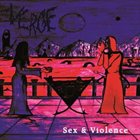 4.00
4.00 |
1 rating

Vehemency
Throughout recent years, Verge has remained as one of my favourite bands, starting with Hatemagic from 2008 and continuing with the 2010 split with Blood Red Fog, Because It’s Wrong. The band’s ability to be so authentically ominous, sick and still beautiful at the same time is mesmerizing, not to forget at all the occult wisdom shining in the lyrical department. Needless to say, expectations for Sex & Violence have been enormous, but luckily I am not disappointed even if I’d be wary to call this better than the album from a couple of years back.
After initial listen, a clear change can be spotted. While Hatemagic had adventurous and wild compositions like ”Assimilation” where different riffs were fired constantly, Sex & Violence is stagnant compared to that - and this is not in a bad way. This album is torturous, repetitive, trance-inducing, atmospheric, and the first track ”Chains” is already to show that: a brooding riff is being repeated as the basis of the song while Wrong spews the lyrics. The song’s power is in the culminating guitar solos that the song is full of in the end, a real beauty of a song. ”Death’s Coitus” goes into utterly maniacal vocal performances but the oppressive repetition is there too, only to continue on the more saddened ”On the Verge”. The centerpiece ”Pride & Vanity”, clocking at almost thirteen minutes, is the epitome of this aura of emptiness, of lost hope.
If the lyrics are left without a read, the listener will probably miss all the point of Sex & Violence’s deliberate oppression: the album reeks of desperation on the occult path to higher knowledge and godhood. On ”Chains”, the protagonist faces the principle of Satan, ’a fiery serpent’, ’a sphinx’, the one behind the tribulations of man. The sphinx asks which path the protagonist will choose in life, and as he says ’I choose both and neither’, the sphinx returns to the ’womb underneath’, and the cycle of samsara continues. ”Death’s Coitus”, then, is a truly impressive rant on human lusts (’I am a god chained to a sewer / my whole being seduces me so can I cut it off’).
”On the Verge” is at the desperation at its fullest, the protagonists mentioning that he knows too much of life to ignore the responsibilities of every man, but he might no longer be able to do what is required from him. This culminates in the last paragraph in which he proclaims that even if he won't fall and instead rises to higher levels of existence, someone else will fall anyway, and the whole world falls with him. The Sex & Violence track trilogy of ”Lust”, ”Hate” and ”Pride” goes into the album’s main subject most profoundly, already apparent in the very first paragraph of ”Lust”: ’The pressure to elevate is now so intense that it often destroys what was meant to be lifted’. One certain paragraph on ”Hate” condenses the album’s theme quite perfectly: ’Why must the highest force bleed out of the lowest channel? My love for the immortal results in sex & violence’. In other words, no matter how he tries to elevate to true gnosis, it always results to acts of a bestial man, without hope of getting away from it: ’Whatever I do now, it seems impossible to escape from this machinery’.
The trilogy analyzed above, however, does not musically stand as high as the songs before it do. All the way through the first five tracks, including the wholly instrumental synth-piece ”Persistence in Failure”, Sex & Violence is one hell of an experience, but ”Lust”, ”Hate”, and ”Pride” don’t quite go as far at musical pleasure. They are fine tracks for sure, but the most I’m astonished that why is there a distortion effect on Wrong’s vocals? He’s most certainly one of the best black metal vocalists out there with its inhuman screams and pitches, so this cheap option does confuse me. This trilogy is the only reason why I am reluctant to go for a higher rating. And do not get me wrong, the music on these three tracks is indeed good, but in relation to the almost mindblowing tracks before them, they tend to pale in comparison. All in all, Sex & Violence is a successful continuation that will most likely keep growing in time, spin after spin. For now, four stars can be given without hesitation - that already says something about how good material we’re dealing with here.